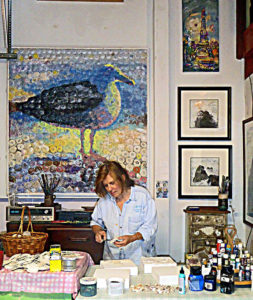Visual artist Mimi Cernyar Fox has spent countless hours wandering the beaches and mudflats near her home in Raymond, Washington, investigating her natural surroundings and seeking inspiration. On one of her explorations she began to look closely at the sand dollars she was collecting on the beach, nearly all of them cracked open or broken by the beaks of seabirds. Why were birds eating so many of them, she wondered? Why weren’t there any whole sand dollars on the
beach anymore?
Soon after that, Fox happened to pick up a copy of The Seattle Times, July 25, 2014. The bold headline read, “Marine birds in decline: Loss of small fish may be to blame.” Mystery solved. The article by environmental reporter Craig Welch detailed the stunning decline of marine birds like white-winged scoters, marbled murrelets and long-tailed ducks due, in large part, to the loss of forage fish and the degradation of the seas and coastline. The birds, she concluded, are reduced to eating the tiny, soft creatures in the
sand dollars.
Fox, who grew up in the Mount Angel – Silverton area as Mary Cernyar and studied theology and philosophy at Mount Angel Seminary after earning her M.F.A. from Washington State, has always been moved to make strong statements with her art work. In graduate school she painted canvases with baby bottles and syringes to make a statement about babies born with AIDS symptoms. Societal indifference to a cause or an injustice has always pushed her hard to take action through her art.
“Drawing is a serious pursuit,” Fox said. “The more you look at something, the more you understand it. I never went anywhere without a sketch book and pastels in the back of my car. It’s just investigating your world, you know. All the mudflats and the sand dollars, that’s my local environment right here. So I said I know I’ve got to be right on doing what I am, using the sand dollar mosaics to make an environmental statement.
“Rather than depict a lot of dead birds laying on the beach covered with plastic bags and trash, my aim is to point to how beautiful the birds are,” she says. “Can you imagine not being able to see the sandpipers peeping and flying out and back with the waves? Or not to hear the magnificent music birds create. I’d rather talk about how beautiful these creatures are and the splendor and bounty of our ocean, and kind of open people’s eyes to it. So they think about it more and care about it more.”
Fox’s work exploring these themes is on exhibition at Gallery 110 in Seattle in July. “Marine Birds in Decline: Paintings & Mosaics runs through July 28.
In addition to her paintings of seabirds and sand dollar mosaics, Fox also delves into ecologically significant mudflats, or tidal flats, areas consisting of mud and sand and pebbles regularly exposed and flooded by the tides. The low wave tides reveal the mud and habitat for bottom-dwelling invertebrates, such as the horseshoe crab, mud snail and shellfish species which become food for predatory birds and fish.
“I want to explore what meaning can be found in the mud. Not to say that the mudflats are beautiful, but when people get in front of the mud they are challenged to think and go into themselves and hear their own response to that mud. It brings you back to our humble beginnings as a species.”
Upon close examination of her mudflat paintings, one sees unanticipated meanings through the collage of objects she has found that were once embedded in the mud. This historical practice, once used by artists in the Dada movement, is a way of expressing chaos in our society, but also suggests how humans have infringed on nature, in this case the sea and the tidal flats.
“It makes you want to weep a little bit, doesn’t it?,” Fox said. “It does me.”
Fox’s sculptures – The Tide Keepers – made from clocks assembled with shorebird carvings and mixed media convey her sense of urgency about the state of our oceans.
“These mud-clocks, with their ticking and chimes, emphasize the fact that time is running out for our neglected oceans and sea life,” Fox noted.
A highlight of the exhibition will be
a presentation by Joseph Karl Gaydos, lead scientist for the SeaDoc Society,
on Saturday, July 21 at 2 p.m.
In addition, Fox was scheduled to give an Artist Talk on July 14.
In addition to Gallery 110, Fox’s work has been shown recently at the Galarie Etienne De Causans in Paris and J. Pepin Gallery in Portland. Gallery 110 is located at 110 Third Ave. South in Seattle. Fox will also be featured in a November 2018 exhibition at Gallery 110 called “Water Water Everywhere.”
